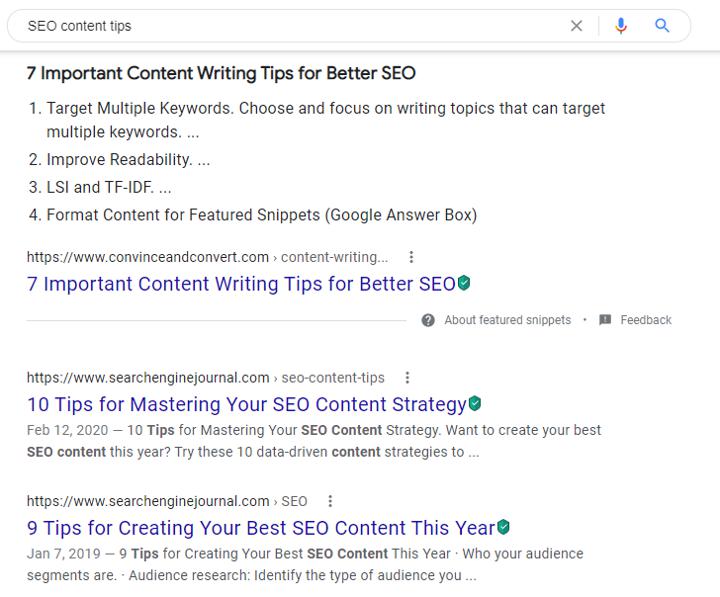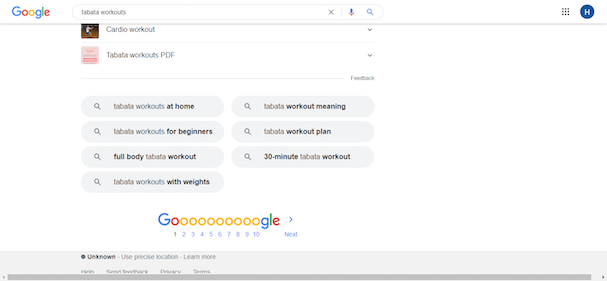Every marketer wants to create content that’ll help them stand out from the crowd. But not every piece of content is powerful enough to engage and persuade the audience to take action.
That’s where SEO (Search Engine Optimization) copywriting comes in.

SEO copywriting is all about writing content that’s engaging and persuasive and ranks highly in the SERPs for the target keywords. It is the most cost-effective way to:
- Attract qualified traffic to your website.
- Build domain authority.
- Build trust among your audience.
- Persuade them to take action in your favor.
Simply put, SEO content is the one that Google easily understands and people look forward to reading, sharing, and linking to.
However, building content that ranks well in the SERPs and creates opportunities for user engagement isn’t easy. That’s why today, I’m sharing a few tips that can help you create high-quality content that ranks well too:
- Know your audience
- Analyze top-ranking pages
- Use search queries
- Focus on readability
- Use bucket brigades
- Write catchy headlines
- Find your go-to SEO copywriting tools
Let’s jump into some SEO copywriting tips for beginners.
1. Know your audience
This may sound like a no-brainer but SEO copywriting is all about creating content as per the search intent. Writing generic content will not cut through the clutter. To write content that stands out in the SERP, you need to write human-centric , customer-centric content.
First, know who you are writing for. This alone will help you create engaging content that converts readers into loyal customers. Do your audience research before creating content.
For instance, create a buyer persona to understand who your reader is and what problems they encounter in their daily lives. Research suggests that content created based on a buyer persona is nearly five times more effective and relevant to the target audience.
The best SEO content lies at the intersection of a brand’s purpose and the needs of your audience. Your audience research should answer the following questions:
- Who is your audience?
- What are their interests/ problems/ concerns?
- What are their primary pain points?
- What channels do they use?
What type of content do they prefer? Webinars, videos, blog posts, podcasts, listicles, or whitepapers?
2. Analyze the top-ranking pages
The most relevant and value-adding content is awarded a place on the first page of Google’s SERP. So how can you get there? By offering content that searchers are looking for.
An easy way to create such content is by going through the top-ranking results for a specific keyword. So, if you want to rank for “SEO content tips,” you need to look for the commonalities between the top results here.

In this case, all the top posts mention terms like “audience research,” “audience avatar,” “Grammarly,” and “search intent.” That’s a good indication that searchers are looking for this information, so you should include these in your content. This will improve the relevance of your content in Google’s eyes and its utility for the target audience.
Finally, tools like Ahrefs’ Content Gap tool can help you gain interesting insights into search intent. For instance, you can subtract the keywords that your website ranks for from the ones that your competitors rank for. The result is a list of keywords that you should be targeting.
3. Use search queries
All content marketers and SEO copywriters sprinkle keywords in their content to give it a boost in the SERPs.
But where do they get these keywords from?
Often it’s Google Keyword Planner.
But you’d be surprised to learn that the keyword planner only tells you about the keywords used in the industry. It doesn’t tell you what your readers are looking for online.
So how can you find the keywords that your audience is using? The answer is in general search and forums related to your niche. Look for the words and phrases commonly used in these forums and use them in your content. Tools like Semrush can help you determine how competitive your keywords are.
Finally, don’t forget to employ Latent Semantic Indexing (LSI) keywords in your content. Keyword stuffing doesn’t impress Google’s AI-powered algorithms. LSI keywords are closely related to words that help Google understand your page better. These keywords can be easily found in “related searches.”
For instance, if you look for the phrase, “Tabata workouts,” you’ll get a list of related topics at the bottom of the first page of the SERP.

Whether you have an internal SEO team or are hiring an external SEO agency, it’s a best practice to research such related terms and include them in your content. This allows Google to better understand what your page is about.
Thinking about hiring an SEO agency? Ask them these 10 questions first!
4. Focus on readability
Your content’s readability directly influences user engagement and experience. In fact, readability, structure, and format are among Google’s top-ranking factors for 2021. Several SEO experts recognize these factors as a mid-tier ranking signal Google considers when ranking web pages.
Improving your content’s readability means making it understandable and easy to digest for the target audience and the search engines. Here are a few pointers to bear in mind to make your articles readable.
- Keep it concise: When writing SEO content, remember that less is more. Keep your matter concise and to the point. Also, the most important information should be at the top.
- Keep your paragraphs short: Short paragraphs are easy to read and understand. It offers the right amount of information to the reader while keeping them engaged.
- Use header tags: Adding headings and subheadings not only improves the readability of a document but also boosts your SEO rankings. Use header tags like <h1> and <h3> for keywords to enhance reader experience.
- Use a simple and readable font: Fonts play an important role in improving the readability of a document. Avoid using complex and small fonts. Keep the text simple, allowing readers to skim through the post with ease.
- Befriend white space: Using white spaces makes a document easily scannable and significantly improves legibility.
- Use tools that measure and improve readability: Tools like SEOPressor Content or Semrush SEO Writing Assistant can help you calculate your content’s readability score and point out the improvements. We’ll see a few more SEO-copywriting tools later in the post.
- Write compelling meta descriptions: a meta description is an HTML element that provides a brief summary of a webpage or landing page, and it can have a significant impact on your SEO. Make sure that it is descriptive and persuasive.
5. Use bucket brigades
We all know that the more time a visitor spends on your webpage, the better are its chances of it getting a high ranking on search engines. Moreover, Google will treat such pages as an authentic and credible source of information. But how can you keep people from leaving your page?
The answer:
Bucket brigades!
See what I just did? I ended a short sentence with a colon. This is called a bucket brigade. They help stir the reader’s curiosity. Using bucket brigades is an old-school copywriting technique that makes people stay on the website for a long time.Here are few examples of bucket brigades:
- Now
- As if that’s not enough
- What does this mean for you?
- But wait, let me tell you something
- And that’s just one side of the story
- In case you might be asking yourself
- Think about it
- And the good news?
- Here’s why
6. Write catchy headlines
Regardless of how valuable your content is, it won’t be able to engage your audience if they don’t click on it. Headlines are the first thing your readers come across on Google’s search results. Hence, your article’s headline should be able to pique the interest of your readers. Simply put, they should be catchy and click-worthy.
Simple tactics like the ones shared below can have a huge impact on the performance of your content.
Use numbers in your headline. (See the title of this piece?). In his article, 5 Reasons Why Using Numbers In Your Headlines Work, Mike Hamers explains:

Write emotional headlines. These are proven to attract increase CTRs and drive more shares. So, make them emotional.

Include power words. Think “sure-fire,” “helpful,” “unparalleled,” and “fantastic," which are highly emotional.
Tailor your headline to the audience. Avoid making general headlines. Be specific. The headline should not just share the core message of your content but also be targeted towards your readers.
7. Find your go-to SEO copywriting tools
SEO content is not merely about stuffing keywords or salesy click baits. Such tactics are widely condemned by search engines as they ruin the online experience for users. In fact, Google penalizes such sites by demoting their ranking or removing the page altogether.
The search engine crawlers have gotten smarter than before—that’s why it’s more than important for marketers to tailor their content to meet the needs of their audience.
There are lots of tools out there, and they range in cost and capability. Here’s what I’d recommend checking to improve your SEO copywriting:
- Content analysis tools: The SEO content analysis space has several contenders. Some tools focus on semantically-focused content optimization while others are more robust. Tools like MarketMuse, Ahrefs, Yoast, Moz, and SEMrush among others allow marketers to create expert-like content that ranks well in the SERP.
- Grammar-checking and content improvement tools: Tools like Grammarly and the Hemmingway app can improve the language used in your content, making it easier to understand.
- Keyword research tools: Tools like Ahrefs Keyword Explorer, Soovle, and KeywordTool.io among others allow marketers to do thorough keyword analysis. Another indispensable tool that can help drive your SEO ranking is Google Search Console. It offers insights into how often certain keywords are searched and how their usage changes over time.
- Keyword density checker: Ideally, keywords should comprise less than 3% of a post, failing which your content may appear to be spam. But how can you monitor this? The SEObook keyword density tool helps content marketers find the perfect balance of keywords in the content, enough to boost SEO without overwhelming the reader.
- Competitor research tools: Use tools like SpyFu, QuickSprout, and SimilarWeb that offer accurate insights related to the competition. The information can be used to drive more traffic to your website, and hopefully boost your conversion rate.
Looking for more options? Check out 18 Content Marketing Tools we recommend!
Use these tips for stronger SEO copywriting
The bad news? Success with SEO copywriting can’t be achieved overnight. You need to invest your time and energy to reach out to and engage the right people with the target message. In turn, you’ll be rewarded by the search engine results pages with a good ranking.
But, these tips I’ve shared above will help you create valuable content that not just engages your audience but also performs well in Google’s SERPs—bringing your business long-term value.
About the author
Tim Ferguson is a writer and editor of Marketing Digest. He enjoys writing about SEO, content marketing, online reputation management, social media, AI, and Big Data. When he is not writing and editing for Marketing Digest, he spends time on learning more about content marketing and getting better at it.You can get in touch with him on LinkedIn.
About the author
Tim Ferguson is a writer and editor of Marketing Digest. He enjoys writing about SEO, content marketing, online reputation management, social media, AI, and Big Data. When he is not writing and editing for Marketing Digest, he spends time on learning more about content marketing and getting better at it.You can get in touch with him on LinkedIn.
